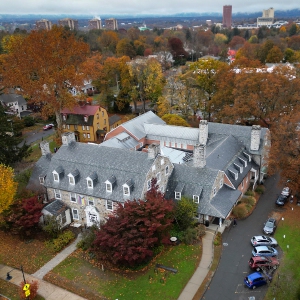The state of solar: In the first of four forums at UMass, experts explore the role solar will play in state meeting its climate plan goals
| Published: 09-14-2023 10:44 AM |
Editor’s note: This is the first in a series of articles from the Western Massachusetts Solar Forum series taking place in September.
AMHERST — Massachusetts has 15 to 18 times the amount of solar potential it needs to support decarbonization requirements, presenting the state with an opportunity to balance solar installation with natural resource and land protection. But that doesn’t mean achieving that goal will come without challenges.
That’s one of the findings to emerge when a panel of experts gathered last Sept. 5 to discuss the current state of solar development in Massachusetts and across the country, including opportunities, initiatives, challenges and goals. The discussion, the first of a four-part Western Massachusetts Solar Forum series taking place in September, provided an overview of where the state stands in terms of solar development and set the stage for the rest of the series taking place every Tuesday this month.
The forums are organized by UMass Clean Energy Extension, Sen. Jo Comerford, Rep. Mindy Domb, and other solar stakeholders and specialists.
“We are lucky to be living in Massachusetts. In Massachusetts we have academia, nonprofits, businesses, government all on the same page when it comes to climate change. … It gives us a unique opportunity to work together to make a change,” said Rebecca Tepper, secretary of the state’s Executive Office of Energy and Environmental Affairs.
Panel experts at the event agreed that solar energy is key to reducing fossil fuel emissions and slowing climate change.
Fortunately for solar advocates, “it’s become cool to invest in solar and clean local renewable energy,” according to Kathleen Doyle, the founder of FireFlower Alternative Energy. Much of that “cool” factor can be attributed to cost savings associated with solar energy as opposed to fossil fuels.
In 2010, solar power was 710% more expensive than the cheapest fossil fuel. Today, solar power costs 29% less than the cheapest fossil fuel, according to a report by the International Renewable Energy Agency. And between 2010 and 2022, the global weighted average cost of solar electricity fell by 89%. Moreover, the U.S. think tank Energy Innovation found that it is more expensive for 99% of coal-fired power plants to keep running than it would be to build new solar or wind facilities.
Article continues after...
Yesterday's Most Read Articles
 Political newcomer defeats Shores Ness for Deerfield Selectboard seat
Political newcomer defeats Shores Ness for Deerfield Selectboard seat
 Granby Bow and Gun Club says stray bullets that hit homes in Belchertown did not come from its range
Granby Bow and Gun Club says stray bullets that hit homes in Belchertown did not come from its range
 Annette Pfannebecker: Vote yes for Shores Ness and for Deerfield
Annette Pfannebecker: Vote yes for Shores Ness and for Deerfield
 Susan Tracy: Support Ukraine funding
Susan Tracy: Support Ukraine funding
 Around Amherst: Bockelman joins in launch of governor’s housing push
Around Amherst: Bockelman joins in launch of governor’s housing push
 Defying the odds: Hadley’s Owen Earle back competing less than two years removed from horrific accident
Defying the odds: Hadley’s Owen Earle back competing less than two years removed from horrific accident
In 2022, the state released the Massachusetts Clean Energy and Climate Plan, which outlines plans to achieve emissions reductions at least 50% below the 1990 baseline by 2030, and to achieve net-zero statewide greenhouse gas emissions by 2050.
The plan estimates that more than 10 times the amount of solar currently installed will be required to reach those reductions.
In response to those goals, the Department of Energy Resources set out to quantify solar potential across the state, with findings now included in the Technical Potential for Solar Study and a corresponding map highlighting suitable land for solar installations.
“The study shows exciting potential for solar growth across the commonwealth and drives home that our solar goal is achievable,” said Elizabeth Mahoney, state commissioner of energy resources.
The study revealed that the state has a solar potential of 506 gigawatts, as opposed to the 27-34 gigwatts required under the climate plan.
“That is really great news because it means that we can be very conscious and considerate in how we build out the rest of our solar production,” Mahoney said.
While there are a number of considerations around building new solar, panelists pointed out two as particularly important: land protection and environmental justice.
“On the one hand, we need a lot more energy, particularly solar, sited throughout our state to meet our electric demands in a renewable way,” said Katherine Antos, state undersecretary for decarbonization and resilience. “On the other hand, we need to protect the integrity of our lands, particularly our forests.”
Protecting forests is key to keeping ecosystems healthy and reducing vulnerability to flooding, droughts and heat — all of which are becoming more common with a warming climate. Moreover, forests are essential to storing and sequestering carbon from the atmosphere, which helps forestall climate change.
“At the state level we’re focused on solutions that try to tackle both prioritizing solar installation on developed land where vegetation and soils have been removed or disturbed, such as rooftop solar,” said Antos. “And second, improving the design of dual-use solar installations on cropland or pasture.”
As for environmental justice, panelists agreed that all people regardless of race, income or other factors should reap the benefits of solar.
“We need to think carefully about how we’re taking these actions, ensuring that our most disadvantaged communities are not overburdened disproportionately by this energy transition,” said Antos, identifying three main priorities: affordability, reliability, and equitable siting practices.
Mahoney identified the Environmental Protection Agency’s Solar for All program as one tool to help bring solar access and projects to low-income communities across the state.
Solar for All, a $7 billion program, will offer up for 60 grants to states, territories, tribal governments, municipalities and nonprofits around the country to provide affordable and resilient solar energy to low-income and disadvantaged communities.
“We think that we’re really poised quite well to offer a competitive application,” Mahoney said. “We’ve struggled to bring the value of solar ownership, the benefits of solar production to these communities, so we think that these monies are going to really unlock a lot of that for us.”
Nicole Steele, a representative from the EPA and Department of Energy, laid out the threefold climate priorities of the Biden-Harris administration: “addressing the climate crisis, ensuring equity, and creating high quality jobs.”
Specific nationwide goals include reaching 100% carbon pollution-free electricity by 2035 and achieving a net-zero emissions economy by 2050.
To do so, according to the DOE Solar Futures Study, the U.S. needs to install an average of 30 gigawatts of solar capacity per year between now and 2025, and 60 gigawatts per year from 2025 to 2030.
About 0.5% of U.S. surface area will be needed for solar development. To put that number into perspective, 43% of surface area is used for agriculture, 5% accounts for urban areas and paved roadways, and Yellowstone National Park covers 0.1% of the nation’s surface area, according to a graphic presented at the event.
“There are many challenges that are going to come with this, whether it’s siting, whether it’s interconnection, whether it’s how we’re going to do this equitably,” said DOE representative Juan Botero.
“Siting is hyperlocal,” he said. “Siting decisions are based on the context of the individual facility, the individual community, the policies in that state or county or municipality. There isn’t a one-size-fits-all solution.”
Maddie Fabian can be reached at mfabian@gazettenet.com or on Twitter @MaddieFabian.
 Sharing a few notes: High schoolers coaching younger string players one on one
Sharing a few notes: High schoolers coaching younger string players one on one Reyes takes helm of UMass flagship amid pro-Palestinian protests
Reyes takes helm of UMass flagship amid pro-Palestinian protests Sole over-budget bid could doom Jones Library expansion project
Sole over-budget bid could doom Jones Library expansion project Amherst poised to hire police department veteran as new chief
Amherst poised to hire police department veteran as new chief 